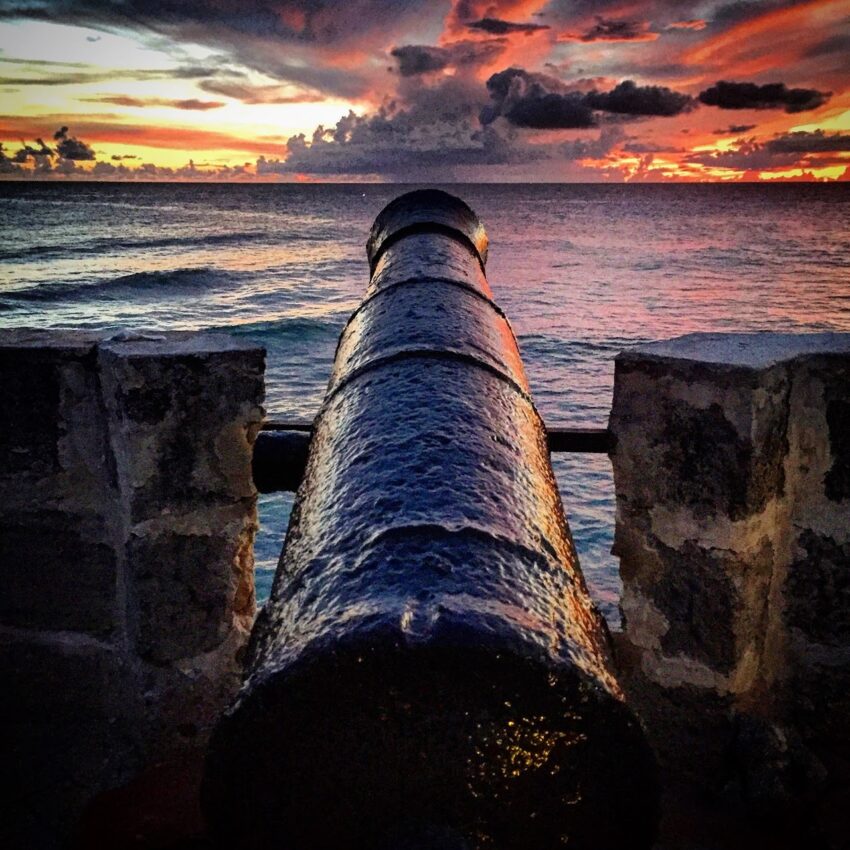
Pirates, Rum, and the Swashbuckling British Towns that Made Them Famous
By Rich Grant
GoNOMAD Senior Writer
Rum might be the worst alcoholic drink ever created. Not because of hangovers, but because it was an integral part of the slave trade
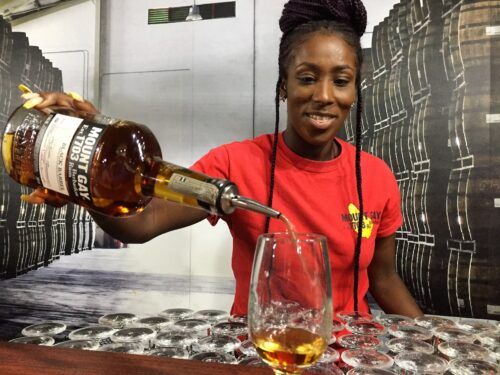
that ripped millions of Africans from their homes and forced them to work hard labor planting sugar in the Caribbean.
Sugar had existed for centuries, but suddenly in 1650, Britain got coffee, followed shortly by chocolate and then tea. Sugar consumption quadrupled between 1650 and 1700 and then doubled again in the next 25 years.
Sugar became white gold. And nothing attracts pirates like gold.
So, in the 17th century, while Spain was busy plundering and looting Mexico and South America, the rest of Europe turned their attention to the 700 islands scattered over a million square miles in the Caribbean. Many of the islands were perfect for growing sugar.
Rum from Molasses
And then it got even better. In the mid-1600s, some unknown genius discovered how to make rum from molasses, the sticky and sweet waste product created when refining sugar. The sugar plantations were dumping molasses in the ocean as worthless. But now they could make rum from molasses! Overnight, the market for rum became even bigger than the demand for sugar.
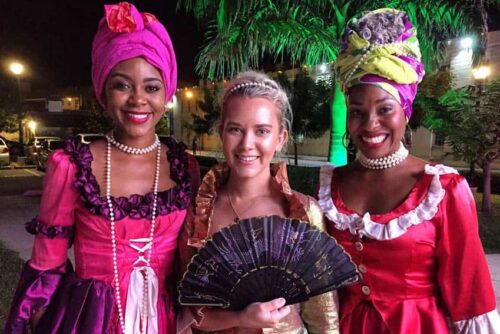
The scenario for European nations was incredible. Steal the islands by killing and enslaving the indigenous people, import more slaves from Africa for the backbreaking work, and pocket untold riches. There was only one challenge.
Pirates!
The Golden Age of Piracy and Where You Can Still Enjoy It
The sugar and rum that led to the colonization of the Caribbean also created dozens of new seaports jammed with unarmed merchant ships of all nations, ripe for the plucking.
Today, there are still towns of British and Dutch origin that relish their historic role as either supporting pirates or fighting them.
These wonderful towns maintain their swashbuckling swagger with restored forts, colonial architecture, pirate museums, and, of course, rum.
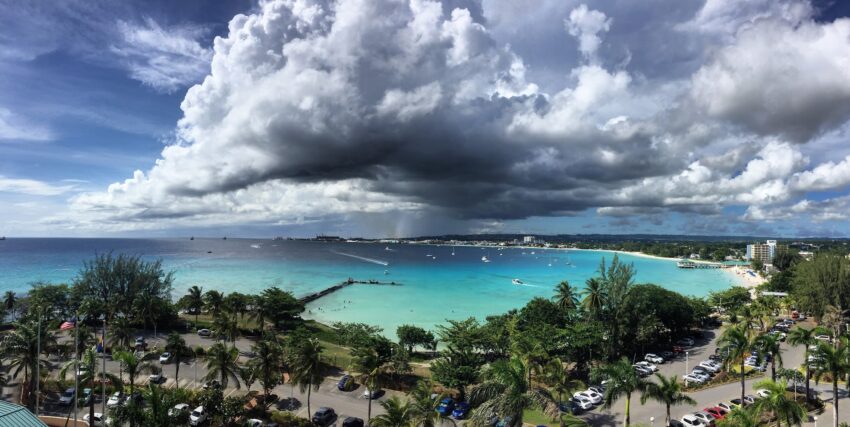
Much of the madness of the era started in Barbados, which is the place to begin. This flat, pear-shaped island off the coast of Venezuela is today a tropical paradise and popular cruise ship stop with large resorts, white sand beaches, and a delightful year-round climate. Simon Cowell and Andrew Lloyd Webber have homes on the island, and the street where the national hero grew up has been rechristened “Rhianna Drive.”
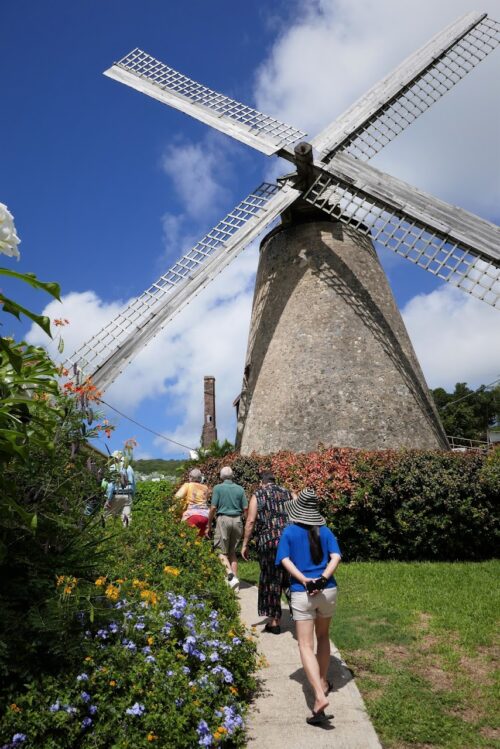
The quiet island is only 21 miles long by 14 miles wide, so it’s hard to comprehend that in the mid-17th century, Barbados was the richest place on earth with a population of 75,000 – larger than all 13 American colonies combined. Most of them were enslaved Africans. Why here?
Well, Barbados is a coral island sitting on top of an underground aquifer that is perfect for growing sugar. Without rivers, energy was a challenge, but Barbados became one of the first energy-self-sufficient places on the planet with more than 400 windmills (second only to Holland) to crush sugar cane and pump up water.
Only one operating windmill remains, but it’s a beauty — and one of only two operating sugar windmills in the world.
In a gorgeous countryside setting surrounded by flowering trees, the Moran Lewis Windmill crushed sugar cane until 1946 and has been restored with equipment dating back to the 18th and 19th centuries.
At certain times they fire up the machinery and crush cane, allowing visitors to taste fresh sugar cane juice (it’s as sickeningly sweet, as you would imagine) and see exhibits on how sugar cane juice was refined to crystal sugar, and then into rum.
The oldest references to rum date to Barbados, which also has the oldest licensed distillery in the world, the Mount Gay Barbados Rum. In the visitor center, you learn the whole history of rum, which dates to 1703.
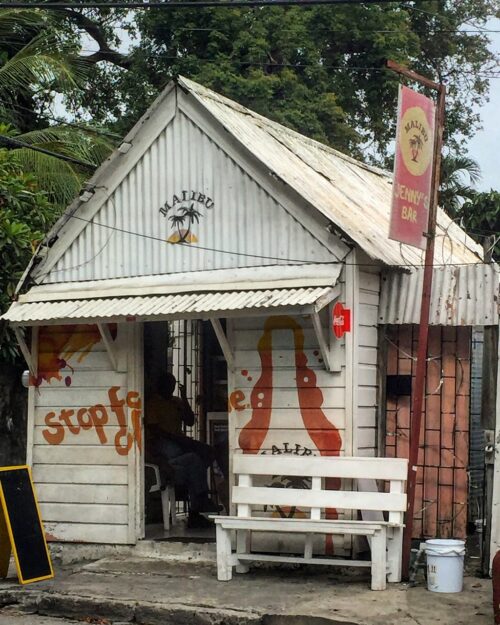
The distillery offers a variety of tours and drinks options, with a very popular lunch & rum tasting for $70 that includes trying several different types of rum paired with Bajan local foods like flying fish and cou cou, (made from corn meal and okra).
The tour includes transportation, which is always important in Barbados where they drive on the other side of the road, British style, a thing you don’t necessarily want to try after sampling rum all afternoon.
A less expensive way to experience rum is to visit a specialty of Barbados – a rum house. There are more than 1,800 rum houses on Barbados.
Buy it and Drink It
Most are simple, small homes, with a counter selling bottles of rum in all sizes, and a small lounge with chairs and tables. You buy a bottle of rum, and then drink it – chatting with locals, playing dominos, and enjoying the weather.
Although rum houses are primarily for locals, the ones in tourist areas (though still authentic) welcome occasional strangers and will make you feel at home.
There are only packaged snacks or maybe there will be an island specialty food truck nearby serving up a fish, ham, or pork “cutter” sandwich, but no cocktails are available in the no-frills rum houses.
Because of its wealth and importance, early Barbados was a heavily fortified place. Unlike the Spanish, who built one huge fortress to protect a port, Barbados had 42 different forts armed with 463 cannons.
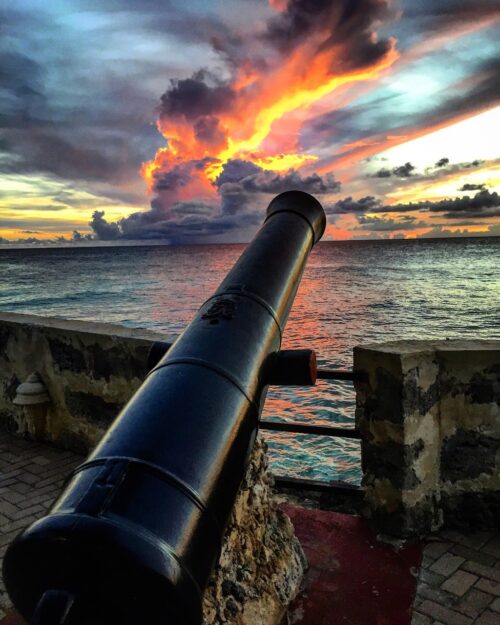
After the British lost the Revolution, they didn’t want to take any chances on losing the Caribbean too, so in 1789, they built the Garrison, which was to become the center of British defense in the Western Hemisphere for 100 years.
The complex survives today and is preserved as a UNESCO World Heritage Site as the most intact and authentic military garrison in the British empire.
It’s possible (although reservations and research are necessary) on Thursday mornings from 9-12:15 p.m., to take the Garrison tour and walk the cannon-studded ramparts of Fort Ann.
Coinciding with the tours at noon on Thursdays is a free changing of the guard ceremony led by the Sentries & Corps of Drums of Barbados. It’s a hoot.
The soldiers (retired and still active soldiers of Barbados) wear Zouave uniforms selected by Queen Victoria in 1856. With the drums beating and shouted commands, it’s colorful and the troops are happy to pose for pictures after the ceremony.
You can’t stay in the Garrison, but the beautiful Hilton Barbados Resort is within a cannon shot of Fort Ann, and actually built on top of the ruins of old Fort Charlotte.
A cannon battery from Fort Charlotte has been restored. Today it only stands guard over the hotel’s swimming pool, but it certainly offers one of the best sunset views on the island.
Pirates Never Attacked Barbados
Pirates never attacked heavily fortified Barbados, but they did capture many ships sailing to and from it because Barbados had a major problem. Every inch of the island was devoted to growing sugar, so there was no room to grow food. The solution? Just like any of the European nations, they sent out an expedition and formed their own colony to supply food for the island. The colony created by Barbados is today Charleston, South Carolina.
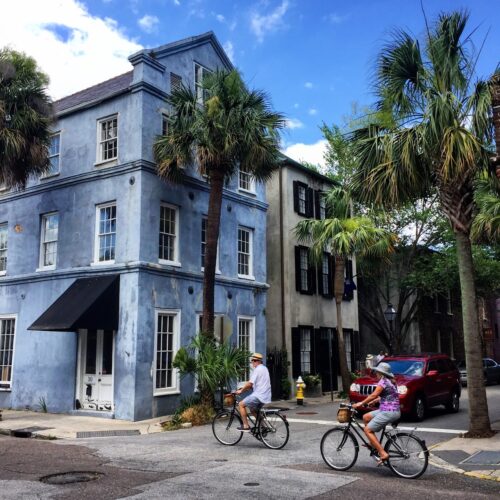
Blackbeard the Pirate and the Siege of Charleston
Charleston is arguably the most beautiful city in America and wins the awards to prove it.
With 1,600 pre-Revolutionary War buildings, tree-shaded streets with brick sidewalks, horse-drawn carriage rides, and historic buildings filled with trendy clubs, restaurants, live music, breweries, and distilleries, it’s a Williamsburg that rocks.
You can see the many influences of Barbados all over Charleston – in the names of the streets dating back to the Barbadian founders, in the vividly colored buildings of pink, yellow, and lavender giving the town a Caribbean feel, and in the basic architecture of the houses, which came to be called the “Charlestown Single House.”
This is the famous one-room-wide house facing the wind. All the rooms in the house opened to a piazza or porch. The windows on both sides of the house could be opened to create a much-needed draft in the heat of summer.
Charlestown’s Carriage Tours
Any walking or carriage tour of Charleston will show you dozens of these Charleston single-house homes – but the idea for them came from Barbados. They will also tell you that the roofs of the piazzas on all the Charleston Single Houses are painted “haint blue.” African slaves believed this color warded off evil spirits and they would not work in a house that did not have it.
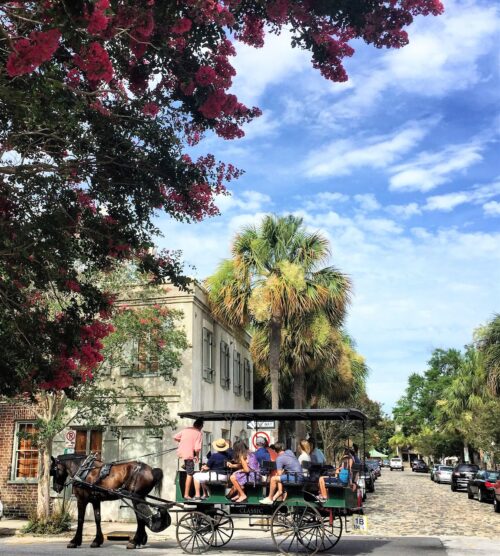
When Mel Gibson filmed The Patriot here, all he had to do was take down signs and put mulch on the streets to create a 1776 atmosphere. The fire department wouldn’t let him remove fire plugs, so every time there was a fire plug in a scene, he placed a woman in a big hoop skirt directly over it.
The downtown neighborhood where a real Revolutionary battle was fought (Upper King Street) is now the hippest hood in town and booming with new eateries and clubs.
Bombed for 20 Months
Despite its popularity, Charleston has an insane history. In April 1863, it was subjected to the largest bombardment in the history of the United States, 20 months of huge cannons firing daily which destroyed much of the town – a town that had already burned to the ground in an 1838 fire that destroyed 1,200 buildings.
Don’t forget that Charleston sits on a major geologic fault and suffered an earthquake in 1886, and then there’s Hurricane Hugo, which in 1989 damaged 80 percent of the homes and left 50,000 people homeless.
But of all the town’s adventures, nothing compares to the siege of Blackbeard the Pirate in Nov. 1718. The most notorious pirate of history was a giant of a man who understood that terror was the better part of valor.
Why fight and risk injury when you could frighten an opponent into surrendering easily? The “Jolly Roger” flag had existed for a long time, dating back to French pirates who soaked a white sheet in real blood to indicate that no quarter would be given to any ship that resisted.
Le Joli Rouge, or, the Jolly Roger
“Le Joli rouge” – the pretty red – translated by drunken English pirates into the “Jolly Roger” – became a symbol of terror and a variety of pirate flags were filled with skull and cross bones, death symbols, and, like Blackbeard’s, a time glass and heart about to be stabbed showing that life was short.
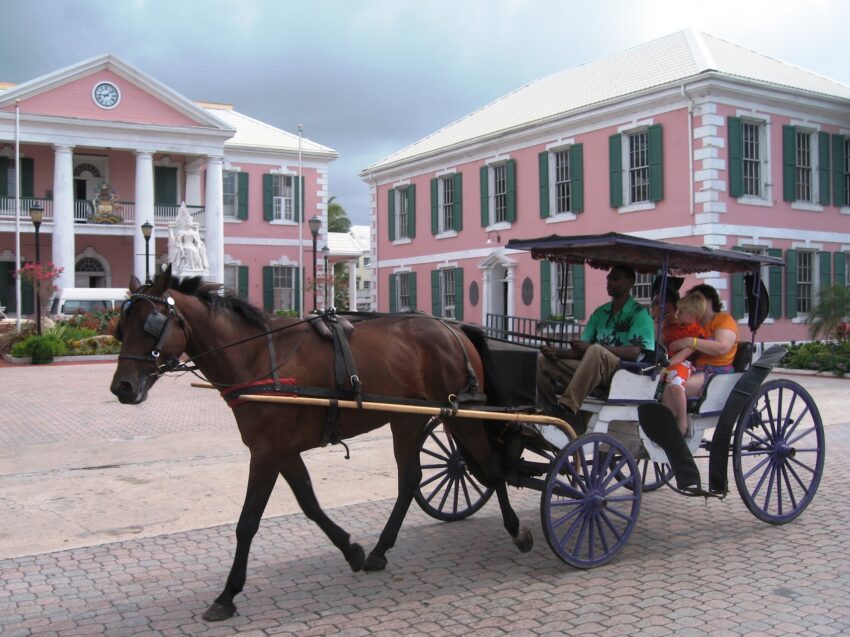
To further the terror, Blackbeard would wear two braces of pistols and put smoking fuses in his hair and beard so that he would appear like a demon from hell, smoking, roaring, and heavily armed as he boarded a captured ship. It’s debated by historians how much actual torture Blackbeard himself indulged in, but many pirates were psychopaths who would increase the feeling that resistance against pirates was madness by actually torturing and killing victims.
Sadistic pirate Francois l’Olonnais liked to use a knife to slit the belly of a victim, pull out their intestines, tie them to the mast, and then make the poor soul dance a jig. Stories like this circulated the seas, and most unarmed merchant ships seeing a Jolly Roger in their wake would surrender immediately, uncover any hidden gold, turn over their cargo, and hope for the best.
This is what happened when Blackbeard sealed off Charleston’s harbor with a small group of pirate ships and began capturing every vessel that when in or out. Terrified, the citizens asked what ransom he demanded. All Blackbeard asked for was a medicine chest.
Apparently, the pirates had just come from Honduras, where some of them had contracted a venereal disease. Supplied with a 100-pound medicine chest, Blackbeard sailed away. Charleston makes the most of this adventure with pirate tours and frequent pirate events for kids at the Charleston Museum (the oldest museum in the nation).
Nassau — The Pirate Republic
It was all well and good for a pirate to capture a ship at sea, but then what? Where to sell and enjoy the booty in a place safe from the British Navy? The answer became the town of Nassau in the Bahamas. The harbor had only one entrance that was easily defended and the water was too shallow for large warships.

During the “Golden Age of Piracy” (1715-1725), the greatest conglomeration of pirates the world has ever known assembled at Nassau and created the actual Pirate Republic that terrorized the Americas and even challenged the European powers.
All of the famous pirates made it to Nassau – 2,000 outlaws including Blackbeard, Black Bart, “Calico Jack” Rackham, Charles Vane, the women pirates Anne Bonney and Mary Read, and dozens of others.
At a time when the planet was ruled by kings and queens, the pirates of Nassau established one of the world’s first democracies. They elected their own captains and officers.
Slaves Treated as Equals
Runaway slaves were treated as equals and nearly a quarter of the crew on some pirate ships were black. Pirates had their own laws and courts and even offered the first naval disability program, allotting different amounts of money to pirates who lost a hand or an arm in battle — more if they lost a leg.
Pirates were loyal to no country and an enemy to all, but the real allure was best summed up by pirate Captain “Black Bart” Roberts, who said of pirating, “It was a short life and a merry one.”
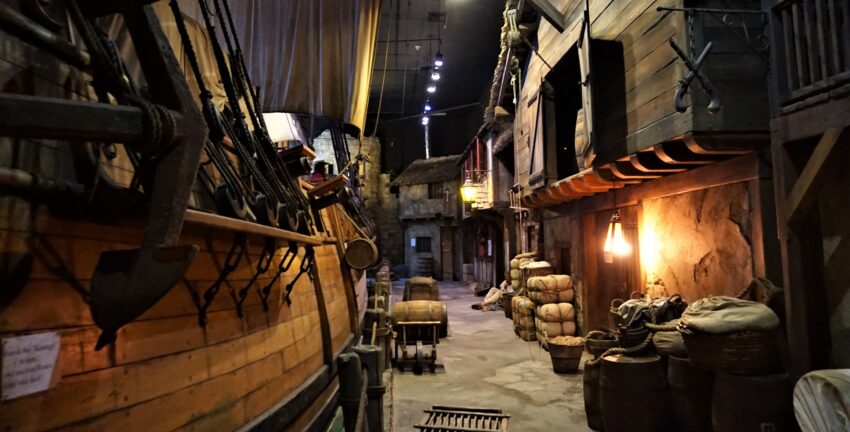
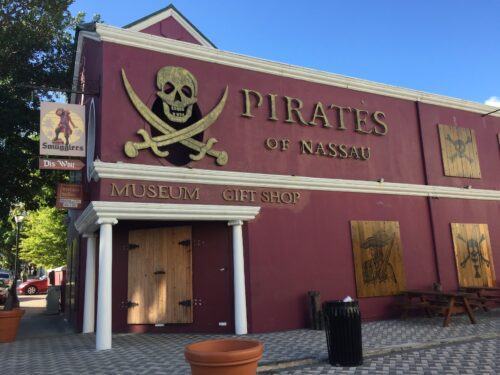
“Are Ye a pirate, sir?”
I was strolling the colonial-looking streets of Nassau, walking past swaying palm trees and buildings painted in bright pastel colors, when a man in a tri-corner hat brandishing a flintlock pistol approached me and said, “Are ye a pirate sir?
Well then, make your mark and sign aboard.” I had found the treasure I was looking for: the Pirates of Nassau Museum. It has been called “the best pirate attraction in the world” by British pirate historian David Cordingly, and while the competition for that honor is slim, I would agree.
Now, your enjoyment of the museum will depend on two things: your age, and how much you have had to drink. Kids, will automatically be fascinated.
I, on the other hand, had made the wise choice to begin my pirate exploring with a stop at the Pirate Republic Brewing Company, a great-looking tavern where a selection of brews has enticing titles like Long John Pilsner, Black Beer’d Stout, Take No Quarter IPA, and Citra Me Timbers pale ale, made with Citra hops, mangos, and tropical fruit.
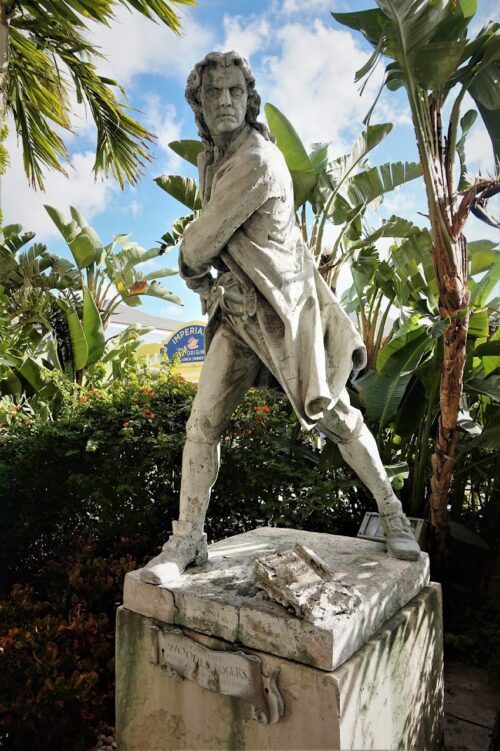
The craft brewery’s logo is a version of the Jolly Roger flag of Nassau pirate Christopher Condent – a jawless skull on top and replacing the crossed bones below, two crossed beer bottles.
A large beer sampling could be the perfect introduction to the museum for many since the museum is a bit like walking (instead of floating) through Disney’s “Pirates of the Caribbean” ride. You enter an enormous room where it is a moonlit night in old Nassau. On the left are a series of taverns lit by candles.
Pirate Noises and Blackbeard’s Ship
You can hear the noises of pirates drinking, singing, and carousing. On the right, is a reproduction of Blackbeard’s ship, the 130-foot-long, 16-gun corvette, The Revenge.
The ship creaks, seagulls squawk and water laps at the stone quay. How good the illusion is to you may depend on how much you have had to drink, but I found it wonderful.
A maze of walkways continues your journey through the museum up onto the ship, into the gun decks, past the cramped living quarters, through a battle, and then a horrifying visit to the ship’s surgeon, all giving you the general impression that life as a pirate was no picnic.
Small wonder one of the museum placards reads: “Life on board a pirate ship consisted of long periods of drunken idleness and brief periods of violent action…Most of their time was spent gambling and drinking huge quantities of alcohol.”
Eventually, England tired of the pirate nuisance and sent Woodes Rodgers (a former pirate himself) to Nassau in 1718 with three warships and an ultimatum for the pirates to choose: “Death or pardon.”
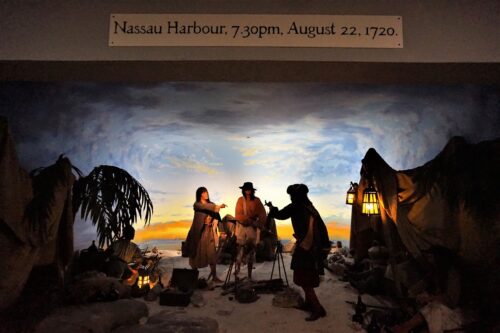
In short order, Rodgers cleaned up the pirate den. He described his actions as: “Expulsis Piratis – Restituta Commercia,” words that still adorn the official seal of the Bahamas – “Pirates Expelled – Commerce Restored.”
Ironically, it is the pirates who have remained heroes. You can’t throw a cutlass in Nassau without hitting a shop selling skull & crossbones t-shirts or “Got Grog?” bumper stickers.
The only tribute to feared pirate-hunter Rodgers is a small statue of him reaching for a brace of pistols, located in the front parking lot of the British Colonial Hilton Hotel.
He looks angry. But at least he looks dashing. The real Rodgers, when he was a pirate, got shot in the face, blowing away his jaw and many of his teeth and it’s doubtful he looked as handsome as he does here.
Strangely enough, the British Colonial Hilton is located on the very spot where Rodgers hanged ten pirates. And it’s also where James Bond stayed in the Ian Fleming book, Thunderball, which is about a modern-day pirate in Nassau highjacking an atomic bomb for ransom. That movie and the later Casino Royal were filmed here.

Eat Like a Pirate
If you want to eat like a pirate, walk down Bay Street from the hotel for about a mile to a village known as “Fish Fry.”
It sits under the cannons of Nassau’s largest fort (Fort Charlotte) and is a row of a dozen local seafood restaurants, where the meal of choice is conch…a snail-like, beautiful pink shell mollusk that tastes like a rubbery scallop and can be grilled, stewed, fried or served cold in a conch salad with green pepper, tomato and onion, cured in lemon juice.
“Cracked conch” (conch fried in a light batter) with peas and rice, (rice and small beans) and fried plantains washed down with the very drinkable local beer, Kalik, is the national dish.
Lonely Planet will tell you not to eat conch because of its near-endangered status and the fact that is quietly being fished out in the Bahamas.
But as a pirate, how could you not taste the national dish? Conch is an important part of the Bahamian diet and a major source of their protein. It’s also delicious.
For fun, stop at D’Water Café at Fish Fry for the Big Daddy Conch Show. Big Daddy (the rather large gentleman with no front teeth) has been cracking conch on the restaurant’s front porch for decades and will show you how it’s done with a hammer and knife. “If you want it any fresher, go and catch it yourself,” as they say.

Though if you walk to the back of the restaurant, you can watch them pull fresh ones out of the water. Experts say it’s kindest to only eat mature, six-year-old conch, and Big Daddy will help you find one. As a pirate, you can finish off the meal with a fine Cuban cigar – legal and cheap in Nassau, but of course illegal to bring home to the U.S.
The Worst Pirate of them All
And if you still want more pirates, just look across the harbor from Nassau to what was in pirate days called Hog Island. Today, thanks to some splendid PR marketing, it’s called Paradise Island. At one time, the majority of this island of resorts and golf courses was owned by the biggest pirate of them all. A scallywag named Donald Trump.
More Pirate Booty: The Pirate Republic, Being the True and Surprising Story of the Caribbean Pirates and the Man Who Brought Them Down by Colin Woodard is the best account of the pirates of Nassau. On the beach, try Ian Fleming’s Thunderball. Although the book is more than 50 years old, Fleming placed this James Bond thriller about modern-day pirates in Nassau and the descriptions of the island hold up well.
The movie (and the newer Daniel Craig Bond movie, Casino Royal) were filmed here. Sean Connery lived on the west end of New Providence Island.
